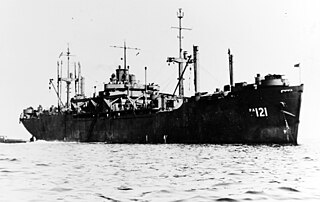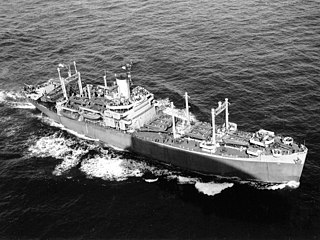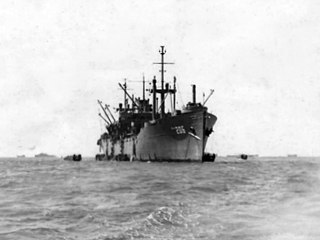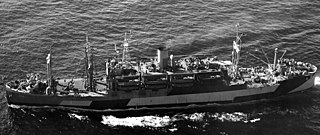
USS Humphreys (DD-236/APD-12) was a Clemson-class destroyer in the United States Navy during World War II. She was named for Joshua Humphreys, a pioneer US shipbuilder.

USS Eldorado (AGC-11) was a Mount McKinley-class amphibious force command ship, named after a mountain range in Nevada. The ship was designed as an amphibious force flagship, a floating command post with advanced communications equipment and extensive combat information spaces to be used by the amphibious forces commander and landing force commander during large-scale operations.

USS Storm King (AP-171) was a Storm King class auxiliary transport of the United States Navy. She was designed as a troop carrier, and named after Storm King Mountain.

USS Hocking (APA-121) was a Haskell-class attack transport in service with the United States Navy. from 1944 to 1946. She was scrapped in 1974.

USS Bolivar (APA-34) was a Bayfield-class attack transport in service with the United States Navy from 1943 to 1946. She was then sold into commercial service and was scrapped in 1973.

USS Doyen (APA-1) was a Doyen-class attack transport in service with the United States Navy from 1943 to 1946. She was scrapped in 1973.

USS Barrow (APA-61) was a Gilliam class attack transport serving in the United States Navy from 1944 to 1946. She was scuttled in 1948.

USS DuPage (AP-86/APA-41) was a Bayfield-class attack transport in service with the United States Navy from 1943 to 1946. She was then sold into commercial service and was scrapped in 1973.

USS Harry Lee (APA-10) was a Harry Lee-class attack transport that saw service with the US Navy during World War II. She served in the Pacific War, as well as in North Atlantic Ocean operations, and safely returned home post-war with seven battle stars to her credit. She was the only ship in her class.

USS Feland (APA-11) was a Doyen-class attack transport in service with the United States Navy from 1943 to 1946. She was scrapped in 1964.

USS James O'Hara (APA-90) was a Frederick Funston-class attack transport that served with the US Navy during World War II and later in the Korean War. The ship was named after a Continental Army officer who fought in the Revolutionary War and who later became Quartermaster General of the US Army.

USS Lamar (APA-47) was a Bayfield-class attack transport in service with the United States Navy from 1943 to 1946. She was sold into commercial service in 1948 and was scrapped in 1971.

USS Newberry (APA-158) was a Haskell-class attack transport in service with the United States Navy from 1944 to 1946. She was scrapped in 1984.

USS Hansford (APA-106) was a Bayfield-class attack transport that served with the US Navy during World War II.

USS Knox (APA-46) was a Bayfield-class attack transport in service with the United States Navy from 1944 to 1946. in 1947, she was sold into commercial service and was finally scrapped in 1971.

USS Windsor (APA-55) was a Windsor-class attack transport in service with the United States Navy from 1943 to 1946. She was scrapped in 1972.

USS Sibley (APA-206) was a Haskell-class attack transport in service with the United States Navy from 1944 to 1946. She was scrapped in 1975.

USS Pierce (APA-50) was an Ormsby-class attack transport that served with the US Navy during World War II.

USS Sheridan (APA-51) was an Ormsby-class attack transport that served with the US Navy during World War II.

USS J. Franklin Bell (APA-16) was a Harris-class attack transport ship. She was built in 1921 and spent 20 years in merchant service as a passenger and cargo liner. She was acquired for the United States Army in 1940 and transferred to the United States Navy shortly after the USA entered the Second World War. She served throughout and after the Pacific War, was decommissioned in 1946 and scrapped in 1948.




















